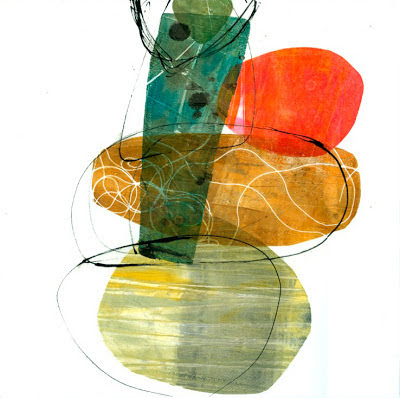2020 Topic 5: Mark Making
Hi
everyone, Keren here with a topic that's nearly as intriguing as it is
simple. From the moment we first held a crayon or paintbrush, we have
been making marks. As children we were instinctive and free and as we
develop, it seems that mark making becomes more complex and we hesitate
often, trying to make the 'perfectly correct' line, dot or dash. When we
think about it at its simplest level, it's certainly something that we
can all attempt. I suspect that freedom to make marks with spontaneity
rather than over-thought might make for more joyous pieces of art.
From
early cave-drawings to sprawling graffiti, mark making is not devoid of
expression or emotion. Boiled down to its essence, a singular mark may
not tell much ( although some artists would beg to differ), but the mark
has been described as the 'language' of the artist (Lynette Ubel) and
can distinguish a piece of art as belonging to us.
When
I consider mark makers from the PaperArtsy family, my thoughts
immediately wander to Seth Apter, who is well known for his marks and
delicious layering of paint and colour. This photo is actually of one
particular stage in the process but you can see the marks so clearly, I
thought it was a great introductory visual. Those of you who know the
PaperArtsy family of designers well, will know that many of the
designers give a solid nod to mark-making among their stamp designs.
One
of the first decisions you'll have to make involves how you're going to
create the marks. There are many ways of crafting your own 'brushes'.
Here's a few handmade ones.
You could create this tool using an item normally purposed for cleaning..
Or this collection of 'brushes'
Once
your implement is chosen. What substrate do you use? Are you making
marks using quicker movement or some intentional gauging? Rapid short
strokes or long gentle swathes of ink? I love this piece by Jacqui Fehl.
There is real life in her strokes. So many examples of mark making are
often in black and white, so this vivacious piece is a treat.
Instinctive
mark making can produce freer responses. This artist closed her eyes
and using one hand to feel for the edge of the paper, moved her body
slowly down the wall, allowing the motion to guide her marks.
Moving
back to implements, I thought this technique of using a leftover
mascara wand is a good option for the environment. We'll be stockpiling
all sorts of objects now!
Calligraphers
make careful marks, often bound by rigid proportional rules. This
example shows a freer side to letter creating and using pen and ink can
produce angular marks.
Often
the marks will be the focus of the piece, but this clever design uses
marks to define areas and bring shading. Look closely!
It's
easy to think of marks as short collections of lines or dots. Mark
making can involve fluid motions that result in spectacular dynamic
pieces.
Heading
back to the PaperArtsy blog, Emma Godfrey has lots of stamps with mark
making in mind. This piece of hers combines lots of different mark
making techniques.
Combining different concentrations of colour and direction makes for exciting marks. I love this piece.
This
art journal is a great example of different types of marks. The
splatters, brush marks, pen work, random painted edges and more.
Changing
medium completely, there's a technique in ceramics called Sgrafito that
involves scraping lines into clay. This artist has also built up part
of the clay after making the marks.
More gauging, but this time into lino. Such beautiful lines and great contrast.
Mark
making on fabric can come in different forms. This piece shows making
marks through spraying over elements (washers), and using different
fibres and stitches. Varying the width and type of fibres results in
beautiful soft marks.
If
we can use any substrate, what about the human body? Etching marks into
skin with ink is the essence of tattooing. Not all tattoos could be
described as beautiful marks but this example is an unique style.
We
can't forget about gel plates in this mark making topic. Gel plates
afford so many ways to make our mark. Whether it's through stencils,
texture transfer, marking the paint, adding objects or stamping, this is
a versatile technique.
This next piece shows a gel plate print using really effective scratching into the plate.
This
next example is one of my favourites. A lively stitched piece using so
many marks to build up texture. It reminded me of book binding stitching
too.
I
hope there is plenty here to get you making marks along with us. They
can be simple or complex, tentative or confident, but the main thing is
to explore how you express yourself in ink, paint, pottery, fabric or
more!
If you want to create along with us, please share on our social feeds so we can see what you get up to. The best places are Instagram @paperartsy or post in PaperArtsy People Group on Facebook. Make sure you tag us in your contributions, we love to see what you get up to in your creative world!

























7 comments:
Fab topic!
What a fabulous topic!!
So informative and inspiring!
Amazing inspirational projects for such a fab topic, Keren .Excellent bit of researching . Thanks for doing so and sharing with us all .
Looking forward to seeing the guest bloggers projects using PA's fantastic products in the coming weeks
x
Great inspirational topics !! Love all the techniques.
Thanks so much for sharing.
Have a nice day, Big hugs
Caty
Wonderful topic and fab samples. xx
Muy interesante todo el material enviado
Investigar texturas soportes y distintas herramientas
Post a Comment